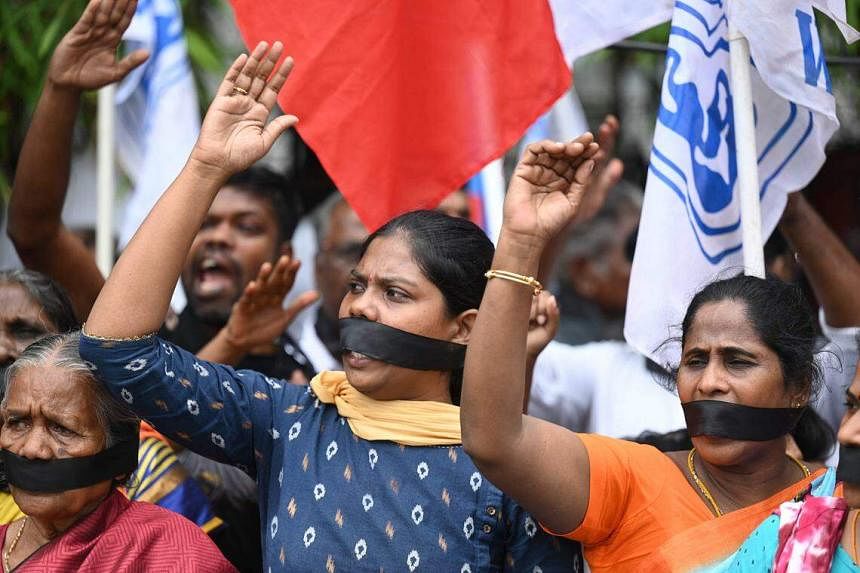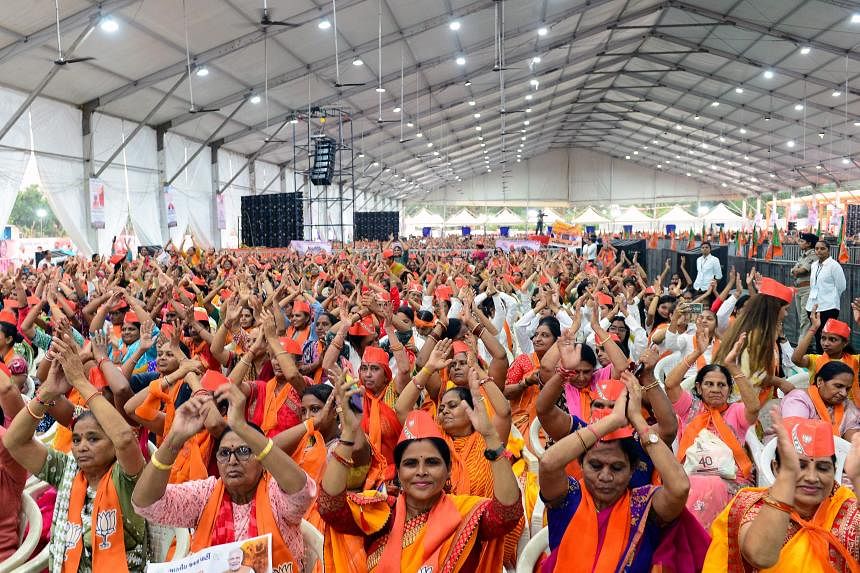NEW DELHI - As India heads into election season, Prime Minister Narendra Modi has ramped up outreach to women voters, who will play a crucial role in determining his bid for a third consecutive stint in power.
State and general elections are coming up, and in a sign of the importance of women voters, who make up half of the electorate, Mr Modi’s Bharatiya Janata Party (BJP) in September successfully shepherded through Parliament legislation to reserve a third of seats in the Lower House of Parliament and state assemblies for women.
The Bill, which Mr Modi called a present to his sisters, is just one of multiple measures the BJP is taking to woo women voters across classes. They include promising free scooters and extra cash handouts in Madhya Pradesh state, which goes to the polls later in 2023, and a door-to-door countrywide campaign starting in October for the 2024 general elections specifically targeting women and telling them about the success of schemes such as free gas connection.
“It’s very important to have the support of women voters. We have seen the changes, whether in Uttar Pradesh or in Gujarat, where we have won, there is visible support from the women electorate. We want to make an intensified campaign focused on women,” Ms Vanathi Srinivasan, national president of the women’s wing of the BJP, told The Straits Times.
In the 2022 Uttar Pradesh state elections, the BJP won 255 out of 403 seats in the state assembly while the main opposition party Congress won two. In Gujarat, also a BJP stronghold, it won 156 of 182 seats and Congress 17.
“And as a party, we are reaching out to various sections (of women voters) and telling them all the policy changes and transformations,” the BJP leader added.
The women’s reservation Bill, which became law with presidential assent last Friday, is expected to be a major message to women voters ahead of elections, said analysts, but they noted that any immediate gains would be marginal for the BJP, as it is not going to be implemented immediately.
The reservation for women will take several years to be implemented, as it is contingent on the next population census, which is already running late and was last done in 2011 with no new dates announced, and a second more complex exercise of redrawing boundaries of constituencies.
Pending for 27 years amid a dozen failed attempts in Parliament due to differences over extra reservation for underprivileged women, it passed with little opposition this time, as parties assessed it would be poor optics to oppose pro-women legislation.
The Lower House saw 454 of 456 MPs voting in favour on Sept 20, and a day later, the Bill passed unanimously with 214 votes in the Upper House.
“How many votes that (the new law) brings to them (BJP) in their kitty, that’s an open question. I think it will be marginal. If it had been implemented now, it would have been a game changer,” said Ms Neerja Chowdhury, senior political journalist and author of How Prime Ministers Decide, assessing that the BJP’s pitch would be that it had done something other governments had failed to do.
“All political parties have recognised the importance of women voters,” she said. “Modi does remain popular among women. He promises political stability and social welfarism of a kind that they are getting things, whether grain, money or gas cylinders.”
Opinion polls show Mr Modi remains the clear front runner in the coming elections, with India Today predicting that the BJP would win 287 of the 543 seats in the Lower House.
Still, the BJP’s recent outreach to women voters also comes on the back of two recent incidents that undermined the party’s message of women’s empowerment.
One was a protest by India’s top women and men wrestlers, including Olympic gold winners, over alleged sexual harassment by former Wrestling Federation of India chief and BJP MP Brij Bhushan Sharan Singh.
The second was a viral video of two women being paraded naked and assaulted by a mob in Manipur, a BJP-held state where the government has been unable to contain an outbreak of ethnic violence.

Seen by his supporters as a champion of women’s rights, Mr Modi, who had not commented on the ethnic violence for weeks, broke his silence to condemn the assault on women.
The political importance of women voters has been growing with every election. In 2019, women voters for the first time outnumbered men by 0.17 per cent. In that election, the BJP won 303 out of 543 seats to the Congress’ 52 in the Lower House in a landslide win.
While not a homogeneous voting bloc like their male counterparts or the only factor for election wins, women, who would earlier follow the men in their family on voting choices, are seen to be increasingly exercising their own franchise as education levels go up.
In the Karnataka state elections, held in May, Congress, the winning party, was preferred by 40 per cent of women voters, while the BJP was chosen by 34 per cent, according to the India Today-Axis pre-poll survey. Congress focused on issues that impacted women the most, such as price rise and inflation, apart from offering schemes like free bus rides and 2,000 rupees (S$33) every month to the woman head of each household. Congress won 135 of the 224 seats in the Karnataka assembly, the BJP 66.
In Rajasthan state, which is going to the polls later in 2023, Congress, which is in power, has offered smartphones and free Internet connections to women voters.
“In states that the BJP lost, such as Delhi or West Bengal, the winning party had a clear advantage among women voters, who do respond to policy appeals by parties more than freebies. Pension, housing, employment schemes for women are more effective to mobilise women voters than the distribution of consumer goods,” said Professor Gilles Verniers, a senior fellow at the Centre for Policy Research.
“This explains the attention that parties pay to women voters in their campaigns or manifestos. No party can afford to neglect them. This, however, does not translate into greater representation of women among candidates. With a few notable exceptions, like the Trinamool in West Bengal or the Biju Janata Dal in Odisha, parties’ records in nominating women candidates are abysmal.” Trinamool fielded women in 40 per cent of the constituencies and Biju Janata Dal in 33 per cent in the 2019 elections.
India, the most populous country in the world, has 600 million women in a population of 1.3 billion. Still, despite rising education levels, the number of women in the workforce is among the lowest in the world.
According to the Centre for Monitoring Indian Economy, only 38.2 million women are employed in India’s workforce, compared with 367.7 million men in 2022 to 2023.
This is also reflected in politics, where women make up just 14.44 per cent in Parliament, according to the Inter-Parliamentary Union. But a key change in recent elections is that women were increasingly voting on gender issues, said analysts, such as lack of jobs, law and order, and safety.
“Women are voting on the basis of gender identity. There is an emergence of a women’s constituency where they are voting as women irrespective of caste, class, et cetera,” said Professor Rajeshwari Deshpande, who teaches politics and public administration at the Savitribai Phule Pune University. She noted that as far as the BJP is concerned, it is still more popular with men than women.
“More men than women have been voting for the BJP. Of course, because the enrolment rate of women in higher educational institutions is rising, they are becoming more aspirational. All political parties, not just the BJP, are aware of the fact there is a definite arrival of women (as an electorate).”


